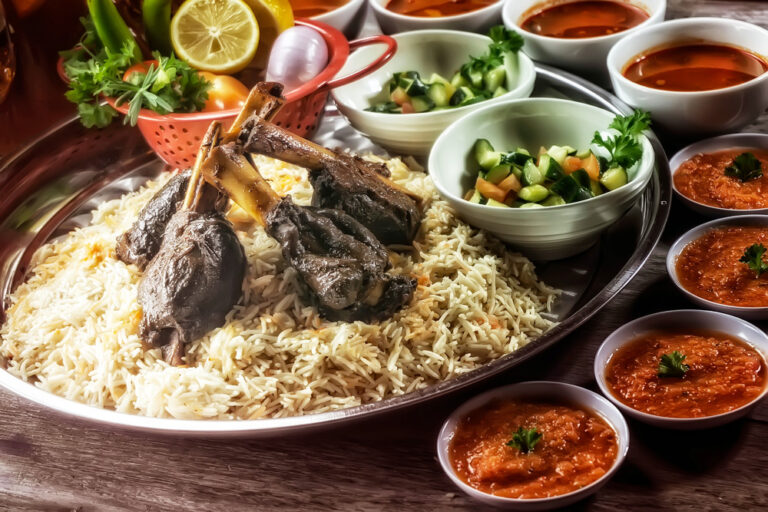Introduction: Saudi Arabian cuisine and its unique ingredients
Saudi Arabian cuisine is a blend of Middle Eastern and Asian culinary traditions. It is known for its rich and aromatic flavors, which are derived from a wide range of spices and unique ingredients. The cuisine is also heavily influenced by Islamic dietary laws, which prohibit the consumption of pork and alcohol. The use of lamb, chicken, fish, and beef in cooking is common, and the dishes are often accompanied by rice, bread, and salads.
One of the defining features of Saudi Arabian cuisine is the use of unique ingredients that are not commonly found in other culinary traditions. These ingredients add depth and complexity to the flavors of the dishes, and are an important part of Saudi Arabian culture and identity. In this article, we will explore some of the unique ingredients used in Saudi Arabian cuisine, and their significance in the local food culture.
The role of spices in Saudi Arabian cuisine
Spices are a crucial component of Saudi Arabian cuisine, and are used to add depth, flavor, and aroma to the dishes. Some of the most commonly used spices include cumin, coriander, turmeric, cardamom, cinnamon, and saffron. These spices are used in different combinations and proportions to create unique flavor profiles in each dish.
In addition to these common spices, Saudi Arabian cuisine also uses a variety of less common spices, such as dried limes, black pepper, sumac, and fenugreek. These spices are often used to add a tangy or bitter flavor to the dishes, and are an important part of the local food culture. The use of spices in Saudi Arabian cuisine is not only a matter of taste, but is also influenced by religious and cultural traditions.
Uncommon ingredients in Saudi Arabian dishes
Saudi Arabian cuisine also uses several uncommon ingredients that are not commonly found in other culinary traditions. One example is qursan, which is a type of wheat that is used to make a variety of dishes, including bread, porridge, and sweets. Another unique ingredient is halwa, which is a type of sweet made from sesame paste and honey.
Other uncommon ingredients used in Saudi Arabian cuisine include sumac, a tangy spice made from the dried fruit of the sumac tree; za’atar, a mix of dried herbs and spices commonly used as a condiment; and samneh, a type of clarified butter that is used in cooking and baking. These ingredients add a distinctive flavor and texture to the dishes, and are an important part of the local food culture.
The use of dates and date products in Saudi Arabian cooking
Saudi Arabia is one of the largest producers of dates in the world, and this fruit plays an important role in the local cuisine. Dates are used in a variety of dishes, including desserts, snacks, and savory dishes. They are also used to make a variety of products, such as date syrup, date paste, and date vinegar.
Date syrup, also known as dibs, is a popular sweetener used in Saudi Arabian cuisine. It is made by boiling dates in water, then straining and reducing the liquid until it becomes thick and syrupy. Date paste, which is made by blending dates into a smooth paste, is used as a filling for sweets and pastries. Date vinegar is a tangy and slightly sweet vinegar that is used as a condiment for salads and other dishes.
The significance of lamb in Saudi Arabian cuisine
Lamb is a staple meat in Saudi Arabian cuisine, and is used in a wide variety of dishes. It is often roasted, grilled, or stewed, and is seasoned with a variety of spices and herbs. Lamb is also used to make kofta, a type of meatball that is typically skewered and grilled.
The significance of lamb in Saudi Arabian cuisine is rooted in religious and cultural traditions. In Islam, lamb is considered a halal meat, which means it is permissible for consumption according to Islamic dietary laws. Lamb is also a symbol of hospitality and generosity, and is often served to guests and at special occasions.
Influences from neighboring countries on Saudi Arabian cuisine
Saudi Arabian cuisine has been influenced by the culinary traditions of neighboring countries, such as Iran, Iraq, and Yemen. One example is the dish kabsa, a rice dish that is similar to biryani and is believed to have originated in Yemen. Another example is the dish haneeth, a slow-roasted lamb or goat dish that is commonly found in Yemeni and Omani cuisine.
In addition to these direct influences, Saudi Arabian cuisine has also been influenced by international cuisine, such as Indian, Chinese, and European. These influences are reflected in the use of ingredients and cooking techniques that are not traditionally found in Saudi Arabian cuisine. However, despite these influences, Saudi Arabian cuisine remains distinct and unique, with its own set of flavors, ingredients, and traditions.

